Bus, Trolleybus and Tram Routes of Kingston upon Hull Corporation, Predecessors and Successors. 1899 to 1986 - Chapter Twenty Six
Bus, Trolleybus and Tram Routes of Kingston upon Hull Corporation
Predecessors and Successors. 1899 to 1986
Chapter Twenty Six
Post-War Timetable Booklets & Leaflets
Not much is known of timetables issued prior to 1945, but at least two booklets were issued in the inter-war period. The first known issue was the edition issued to coincide with the co-ordination agreement in July, 1934. This book gave an interesting insight into life in the mid 1930’s, as well as information on the provision of public transport in Hull and the surrounding areas. On the transport front, it gives details and the purposes’ of the coordination agreement, along with time and faretables for all bus and tram services in the city. Of interest with regard to fares, is the listing of night service and Sunday morning fares. It is surprising the different fare levels charged on these services, as compared with the normal day fares, this must have been a nightmare for conductors of the time. The only other inter-war timetable seen was dated for 1938, and gives the final pre-war network, including all three modes of transport, namely trams, buses and trolleybuses.
Post-war timetables commenced publication in March, 1946; this book gave the first post-war network, again using all three modes of transport. Timetables were given for each service along with faretables for each service, a feature which was continued until 1963, when faretables ceased to be published, until 1970, when they were again featured. This continued then until deregulation. The level of fares and increases thereto would make an interesting study, but this is beyond the scope of this work. The post-war timetables were numbered consecutively from 1 and continued up to issue 77 in 1983, when the booklets were replaced by separate leaflets, which were held in a loose leaf binder, which was available from the City Transport for the sum of a pound.
Timetable booklets were issued in March and October, 1946(Issues 1 and 2); the next being in October, 1947 (no 3) and July, 1948 (no 4) then there were two editions in 1949, July (no 5) and October (no 6), and 1950/1 saw a further four (no’s 7 to 10) in April and October. April 1952 and 1953 editions 11 and 12; 1954 saw editions 13 and 15 issued in April and October, 1954. It is believed that issue 14 was not issued, but 14 was given number 13 in error, 13 not being intended to be used. Between 1955 and 1967, timetables were issued twice yearly, in April and October (issues 16 to 41). The next ten issues (42 to 51) were dated between 1968 and 1971 as follows: 42 and 43 were issued in June and October of 1968. The following year saw issues 44 to 47 in March, June September and December. Issues 48 and 49 were issued in March and September of 1970. 1971 saw the issue of numbers 50 and 51, the latter of which was issued in September. The date of number 50 was issued on 15/2/71 to coincide with the introduction of decimal currency. Between 1972 and 1980, timetables were issued twice yearly in March (1972) or May (1973 - 75/77/78) or June (1979/80), the second issue being in September (for all years). The odd year out was 1976 when the first edition appeared in July. These issued were numbered 52 to 69. In 1981 there were four issues in January, March, May and September, whilst 1982 and 1983 were issued in May and September. Issues were numbered 70 to 77, and number 77 (September 1983) was the final booklet to be produced.
From 1984 the timetables were issued in thirty one separate leaflets, which could be stored and the loose leaf binder referred to earlier. The first leaflets were issued in June, and thenceforth leaflets were issued as needed, when the routes or services which they contained were subject to alteration. A further set of timetables was issued in July, 1985, and the final pre-deregulation set was issued a year later in July 1986. Unofficially these were issues 78 to 80. This latter set was the first to be issued by the limited company.
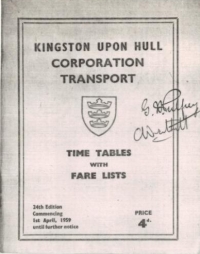
Over the years, there were three basic types of cover to the booklets, although the third type had nine variations. The first type of cover had six variations, mainly in the colour of card used. Editions 1, 2 and 5 to 7 featured a semi-glossy light azure card cover, overprinted in red and black. The city coat of arms and borders were in red and the lettering in black. Issues 3 and 4 were identical but the card was pink and yellow respectively. A semi-glossy dark azure cover featured on editions 8 to 11. The third type was a plain card cover in a turquoise blue (editions 12 to 17), the final variation featured a dark sky blue card cover. This final type was on editions 19 to 28. It is uncertain if edition 18 was of type three or four.
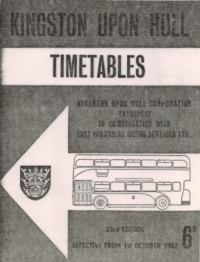
The first major change in presentation occurred after seventeen years, and it featured a white card cover printed in azure and black. A line drawing of the then new Roe bodied Atlanteans was featured prominently. Editions 29 to 36 carried this type, which was in use from 1962 to 1965. From 1965 yet another change of format for the front cover was introduced. Again white card was used, and this time there were azure blue bands at the top and bottom of the cover. The top band carried the title in white, whilst the lower one carried the price of the booklet. Above this lower blue panel was a white panel which gave the edition number and effective date in black. In between this and the top blue panel was a photograph of a new(er) bus to the fleet. This photograph was changed from time to time. All in all there were nine different photographs used in this final series which were used between 1965 and 1983. The photographs were as follows:
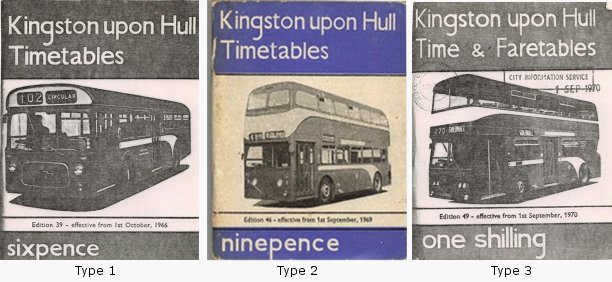
Type 1) Leyland Panther PSUR1.1 - Roe B45D No. 172 (BKH 172B) editions 37-9.
Type 2) Leyland Atlantean PDR1/1 - Roe H44/31F No. 226 (JRH 426E) editions 40-7.
Type 3) Leyland Atlantean PDR1A/1 - Roe H43/28D No. 275 (TKH 275H) editions 48 to 52.
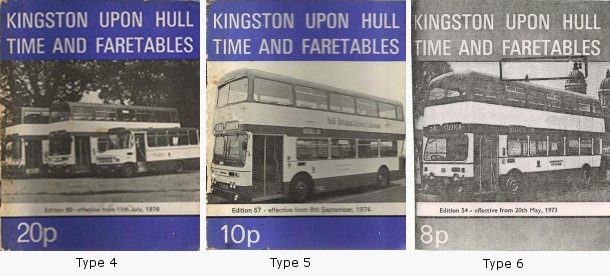
Type 4) Leyland Atlantean PDR1/1 -Roe H44/31F No. 221 (JRH 421E) editions 53/4. This vehicle was painted in the new City Transport livery, against a false background of the town docks offices. The insignia has been retouched as have the destination indicators.
Type 5) Leyland Atlantean AN68/1R - Roe H43/29F No. 318 (DRH 318L) editions 55 to 59. The photograph shows the vehicle as on display at the 1972 Commercial Motor Show at Earl’s Court. It is in the new livery, but shows detail differences to that which was finally adopted as standard.
Type 6) A representative group of new vehicles
a) Scania BR111DH “Metropolitan” - MCW H44/29F No. 413 (KRH 413P)
b) Leyland Atlantean AN68R/1R -Roe H43/29F No. 353 (NAT 363M)
c) Ford A0609 -Tricentrol B23F No. 14 (MAT 15P). Editions 60 to 66.
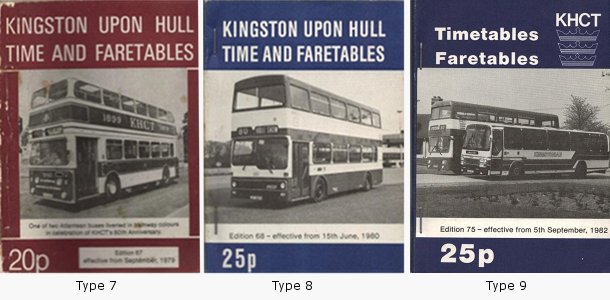
Type 7) Leyland Atlantean PDR1A/1 -Roe H44/31F No 245 (PRH 245G) edition 67 this was the 80th anniversary edition and the photo was one of the two Atlanteans repainted in the original crimson and broken white livery. The blue on the cover was replaced by crimson, actually nearer to brown!
Type 8) MCW Metrobus DR102/7 - MCW H43/30F no. 507 (LAT 507V) editions 68 to 73.
Type 9)
a) Leyland Atlantean AN68C/1R - Roe H43/31F no. 372 (WAG 372X)
b) Leyland Leopard PSU3F/4R - Plaxton C51F no. 21 (AAG 21X) editions 74 to 77.
From the start of the post-war issues, each timetable booklet faetured a map of the current network. Editions 1 and 2 featured the map as a centrefold, which, although undated, would have been dated 1945. A revised edition appeared in editions 5 and 6, this being dated most probably, 1948, it is not known which version appeared in editions 3 and 4. From edition, a larger, fold up version was included glued to the inside back cover, the rear of the map carried advertising material. It was dated 14/04/50, and it appeared in editions 7 to 11. The map was updated, and the advertising was removed from the rear. Although clearly updated, it still carried the 1950 date of the original version, it appeared in editions 12 and 13, and probably 14 and 15 also, but this is not certain. The 1950 map was again revised for editions 16 and 17, again, no advertising was carried on the rear, and no subsequent maps by the Transport Department ever did so again.
A new era of mapping appeared with edition 18, the map being drawn by Mr G. M. O’Connell, it was dated 14/10/55, and appeared in edition up to 22. On the rear, the map now contained enlarged maps of Longhill Estate, Bilton Grange Estate, Sutton Trust Estate and Greatfield Estate, showing bus routes running through them. This feature was to be continued on most subsequent maps, and the development of the outer estates can be traced through them. Editions 23 and 24 received a new route map dated 18/06/58, but the reverse was identical to the earlier maps. A new route map appeared in edition 25, but it was slightly revised for editions 26 and 27, both versions were dated 23/08/59, the reverse, however carried a redrawn version of the estate maps. The earlier version appeared in edition 28, but this may have been an error as the redrawn maps featured in editions 29 to 31. The route maps for these four editions were dated 21/02/61 (28/9) and 02/02/62 (30/1).
The route map of edition 32 was dated 24/01/63 and the reverse carried enlarged maps of Longhill, Boothferry and Greatfield estates, this map also having the same date. Route maps for editions 33 to 35 were dated 28/06/63, 02/03/64 and 01/09/64 respectively, whist the reverse maps were dated 01/09/63, and Longhill estate was replaced by Ings Esate. In editions 36 and 37, the route map was dated 02/03/65 and the reverse was dated 17/03/65, and now showed Orchard Park, Boothferry and Ings Estates, this was revised on map dated 15/02/66, which was on the reverse of a route map of the same date, this was with edition 38. It also appeared on the reverse of route maps in editions 39 (17/08/66); edition 40 (28/03/67) and edition 41 (09/67). From this point the reverse map was of the developing estates of Bransholme and North Bransholme. There ten revisions to the Bransholme maps, the original map was dated March, 1968 and was in editions 42 and 43. Revisions were dated March, 1969 (editions 44/5); July, 1969 (editions 46-8); August, 1970 (editions 49, 50); September, 1971 (editions 51/2); September, 1972 (editions 53/4); September, 1973 (editions 55-8); September, 1975 (edition 59); June, 1976 (editions 63-4); September, 1978 (editions 65-7) and June, 1980 (editions 68-72). From this point the reverse of the route maps remained blank. Route maps for the above editions were as follows: April, 1968 (42); September, 1968 (43); March, 1969 (44/5); August, 1969 (46/7); February, 1970 (48); August, 1970 (49/50); September, 1971 (51/2); September, 1972 (53/4); September, 1973 (55/6); May, 1974 (57/8); September, 1975 (59); June, 1976 (60-4); September, 1978 (65/6); September, 1979 (67); June, 1980 (68-71) and May, 1972 (72). This latter map was the first unco-ordinated map, which showed only East Yorkshire routes numbered under 100. The final route map to be issued was dated September, 1981, and it appeared in editions 73 to 77.
The loose-leaf issues carried a route diagram in each separate leaflet, and there was no map of the complete network between the 1981 version above and the pre-deregulation map issued by the City Council. This broke new ground, in that it was in full colour, and each route was colour coded. There have been several similar maps of post-deregulation services, issued by the City Council, but these are outside the scope of the present work.
As stated earlier, from June, 1984, the timetables were issued in loose-leaf format, which allowed easier updates to the timetables, and, of course, made it easier for members of the public, who only wanted timetables for specific routes. Added to which, the leaflets were issued free of charge, wheras the booklets had incurred a small charge. There were three issues, unoficially numbered 78 to 80. The first was dated 24th June, 1984, the other two being dated 28th July, 1985 and 27th July, 1986. This latter was the first to be issued by the Limited Company, and was for the pre-deregulation network, which featured completely new routes and numbering system. The first two were of the traditional type.
The 1984 edition consisted comprised thirty one leaflets. Leaflet 1 comprised general information, service and leaflet index, a gazetteer of places served also diagrams of stands in the Coach Station and Bransholme Centre and diagram of city centre bus stops. Leaflet 2 contained all the conditions and regulations. After this followed the individual service timetable leaflets, of which numbers 3, 4, 7, 21, 22 and 25 covered East Yorkshire services supported by Hull City Council. Leaflet 26 covered works services 27 and 28 covered school services in west/north Hull and east Hull respectively. Sports services were on leaflet 29. The Ferrybus and the heritage service were on the final two leaflets. All the other leaflets covered normal KHCT services in numerical order. Subsequent issues in the first series were a list of amendments on the 21st December, and on the 21st of January, 1985, leaflet 32s issued to cover the Handirider group of services, for disabled passengers. All leaflets in this first series were printed on separate A6 sheets, whereas the second and third series were printed on A5 sheets folded in half.
The second series of leaflets was issued in July, 1985, and comprised of only 20 leaflets, as the East Yorkshire services were no longer included. Leaflets 1 and 2 were similar to the first series, and numbers 3 to 14 covered the normal services; numbers 15 to 18 were the equivalent of numbers 26 to 30 of the first series. Number 19 was the Handirider whilst 20 covered the new 99X Bransholme express service. Subsequent issues in the second series were issued 10/11/85: leaflets 3, 7, and 14; 06/01/86: leaflet 11; 19/01/86: leaflet 4. The final issues were dated 04/05/86 and consisted of leaflets 4, 5, 7, 12, 14 and 14. The third and final series was issued on 27/07/86 and consisted of twenty leaflets, covering the pre-deregulation network. Only one amendment was issued before deregulation and this was leaflet 2.
I am indebted to Philip Lightfoot for information regarding some early post-war timetables.
Keith Easton
01/2012
Click here to view the seperate Index for Chapter Twenty Six
29/05/12 - 08:01
Well done Keith - another good article. You mention little is known about pre-war timetables. The first reference that I have come across was a contract with Harvey's Advertising Agency in February 1933 to produce 20,000 copies of the official timetable (which implies that there was one already) free of charge funded by advertising of course.
Booklets were issued with details of night and Sunday morning services.
Details of all services and timetables were to be found in the monthly Hull Railway Guide and Insurance Diary published by Archibald and Johnsons Ltd. I have the November 1935 and June 1938 editions (both priced at 2d each with annual subscription of 2/6!
The October 1961 edition contained no service 61/5 information as motorbus replacements 13/23 were expected to be introduced at an early date (which turned out to be July 1962).
Malcolm J Wells
01/06/12 - 08:01
Hello Malcolm, many thanks for your comments. With regards to prewar timetables, the only ones that I have seen, are the July, 1934 (co-ordination) edition, printed by Harvey's, as you stated. I have a photocopied version of this booklet, the only other that I have seen in an edition dated, September, 1938. I have a photocopy of the list of services. In the 1934 edition nearly every other page has space for advertising, most of which was vacant! I have not seen any copies of the Hull Railway guide, but maybe the History Centre, may have copies of them. Your comment regarding edition of October '61 and the lack of the 61/5 trolleybuses underlines the fact that even timetables are not entirely reliable! A bit worrying, as most of the book is based squarely on the timetables, even the dates being mainly of the timetable which showed the route and changes thereto. I have also never seen any of the night and Sunday morning service booklets, and I have assumed that in the absence of any information to the contrary, the services were generally discontinued around the outbreak of the Second World War.
Keith Easton
03/06/12 - 07:30
I think the timetable booklets are very reliable but there are anomalies. The post 1958 to 1960 versions give only service 61 journeys at "every few minutes" but photographs show that service 65 operated regularly, the last being the day before abandonment in July 1962. From about 1960 trolleybus services were shown as "every few minutes" rather than actual frequencies.
Malcolm J Wells
Comments regarding the above are more than welcome please get in touch via the 'Contact Page' or by email at
If you have a bus related article that you would like to appear on this site please get in touch via the 'Contact Page' or by email at
All rights to the design and layout of this website are reserved Old Bus Photos does not set or use Cookies but Google Analytics will set four see this
Old Bus Photos from Saturday 25th April 2009 to Tuesday 23rd April 2024